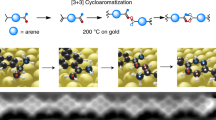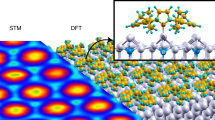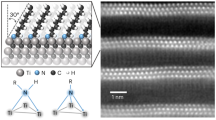Abstract
Materials containing organic–inorganic interfaces usually display a combination of molecular and solid-state properties, which are of interest for applications ranging from chemical sensing1 to microelectronics2 and catalysis3. Thiols—organic compounds carrying a SH group—are widely used to anchor organic layers to gold surfaces6, because gold is catalytically sufficiently active to replace relatively weak S–H bonds with Au–S bonds, yet too inert to attack C–C and C–H bonds in the organic layer. But although several methods4,5,6 of functionalizing the surfaces of semiconductors, oxides and metals are known, it remains difficult to attach a wide range of more complex organic species. Organic layers could, in principle, be formed on the surfaces of metals that are capable of inserting into strong bonds, but such surfaces catalyse the decomposition of organic layers at temperatures above 400 to 600 K, through progressive C–H and C–C bond breaking7. Here we report that cycloketones adsorbed on molybdenum carbide, a material known to catalyse a variety of hydrocarbon conversion reactions8,9,10,11, transform into surface-bound alkylidenes stable to above 900 K. We expect that this chemistry can be used to create a wide range of exceptionally stable organic layers on molybdenum carbide.
This is a preview of subscription content, access via your institution
Access options
Subscribe to this journal
Receive 51 print issues and online access
$199.00 per year
only $3.90 per issue
Buy this article
- Purchase on Springer Link
- Instant access to full article PDF
Prices may be subject to local taxes which are calculated during checkout




Similar content being viewed by others
References
Crooks, R. M. & Ricco, A. J. New organic materials suitable for use in chemical sensor arrays. Acc. Chem. Res. 31, 219–227 (1998).
Wolkow, R. A. Controlled molecular adsorption on silicon: laying a foundation for molecular devices. Annu. Rev. Phys. Chem. 50, 413–441 (1999).
Jeon, N. L. et al. Patterned polymer growth on silicon surfaces using microcontact printing and surface-initiated polymerization. Appl. Phys. Lett. 75, 4201–4202 (1999).
Buriak, J. M. Organometallic chemistry on silicon surfaces: formation of functional monolayers bound through Si-C bonds. Chem. Commun. 1051–1060 (1999).
Yan, C., Zharnikov, M., Gõlzhãuser, A. & Grunze, M. Preparation and characterization of self-assembled monolayers on indium tin oxide. Langmuir 16, 6208–6215 (2000).
Bain, C. D. et al. Formation of monolayer films by the spontaneous assembly of organic thiols from solution onto gold. J. Am. Chem. Soc. 111, 321–335 (1989).
Somorjai, G. A. Introduction to Surface Chemistry and Catalysis 420 (John Wiley & Sons, New York, 1994).
Oyama, S. T. in The Chemistry of Transition Metal Carbides and Nitrides (Blackie, London, 1996).
York, A. P. E. et al. Molybdenum and tungsten carbides as catalysts for the conversion of methane to synthesis gas using stoichiometric feedstocks. Chem. Commun. 39–40 (1997).
Chen, J. G., Frühberger, B., Eng Jr, J. & Bent, B. E. Controlling surface reactivities of transition metals by carbide formation. J. Mol. Catal. A 131, 285–299 (1998).
Solymosi, F. & Szõke, A. Conversion of ethane into benzene on an Mo2C/ZSM-5 catalyst. Appl. Catal. A 166, 225–235 (1998).
Nugent, W. A. & Mayer, J. M. Metal-Ligand Multiple Bonds Ch. 4 (Wiley, New York, 1988).
Silverstein, R. M., Bassler, G. C. & Morrill, T. C. Spectrometric Identification of Organic Compounds 5th edn, Ch. 3 (Wiley, New York, 1991).
Cataliotti, R., Giorgini, M. G., Paliani, G. & Poletti, A. The vibrational spectrum of crystalline cyclobutanone. Spectrochim. Acta A 31, 1879–1884 (1975).
Cheon, J., Dubois, L. H. & Girolami, G. S. Mechanistic studies of the thermolysis of tetraneopentyltitanium(IV). 2. Solid state and ultra-high-vacuum studies of the chemical vapor deposition of TiC films. J. Am. Chem. Soc. 119, 6814–6820 (1997).
Bryan, J. C. & Mayer, J. M. Oxidative addition of cyclopentanone to WCl2(PMePh2)4 to give a tungsten (VI) oxo-alkylidene complex. J. Am. Chem. Soc. 109, 7213–7214 (1987).
Bryan, J. C. & Mayer, J. M. Oxidative addition of carbon-oxygen and carbon-nitrogen double bonds to WCl2(PMePh2)4. Synthesis of tungsten metalloxirane and tungsten oxo- and imido-alkylidene complexes. J. Am. Chem. Soc. 112, 2298–2308 (1990).
Spessard, G. O. & Miessler, G. L. Organometallic Chemistry 348 (Prentice-Hall, New Jersey, 1997).
Furstner, A. Olefin metathesis and beyond. Angew. Chem. Int. Edn Engl. 39, 3012–3043 (2000).
Kapoor, R. & Oyama, S. T. in Synthesis and Characterization of Advanced Materials (eds Gruen, D. M. & Malhotra, R.) Ch. 18 (ACS symposium series, American Chemical Society, Washington, 1998).
Lofberg, A., Frennet, A., Leclercq, G., Leclercq, L. & Giraudon, J. M. Mechanism of WO3 reduction and carburization in CH4/H2 mixtures leading to bulk tungsten carbide powder catalysts. J. Catal. 189, 189–183 (2000).
Park, S.-C., Park, H. & Lee, S. B. Reaction intermediate in thermal decomposition of 1,3-disilabutane to silicon carbide on Si(111). Comparative study of Cs+ reactive ion scattering and secondary ion mass spectrometry. Surf. Sci. 450, 117–125 (2000).
Zhang, Y. et al. Heterostructures of single-walled carbon nanotubes and carbide nanorods. Science 285, 1719–1722 (1999).
Mayr, A., Yu, M. P. Y. & Yam, V. W.-W. Electronic communication between metal centers across unsaturated alkylidyne ligands. J. Am. Chem. Soc. 121, 1760–1761 (1999).
Wang, D., Lunsford, J. H. & Rosynek, M. P. Characterization of a Mo/ZSM-5 catalyst for the conversion of methane to benzene. J. Catal. 169, 347–358 (1997).
Tanaka, K.-I. & Takeshiro, N. Atomic-scale mechanism for the activation of catalyst surfaces. J. Mol. Catal. A 141, 39–55 (1999).
Weck, M., Jackiw, J. W., Rossi, R. R., Weiss, P. S. & Grubbs, R. H. Ring-opening metathesis polymerization from surfaces. J. Am. Chem. Soc. 121, 4088–4089 (1999).
Watson, K. J., Zhu, J., Nguyen, S. T. & Mirkin, C. A. Hybrid nanoparticles with block copolymer shell structures. J. Am. Chem. Soc. 121, 462–463 (1999).
Acknowledgements
We acknowledge the technical assistance of A. Bouffard and J. Lafrerière, and financial support from the National Science and Engineering Research Council (NSERC) and Le Fonds pour la Formation de Chercheurs et l'Aide à la Recherche (FCAR). We thank S. T. Oyama for the preparation of the molybdenum carbide samples.
Author information
Authors and Affiliations
Corresponding author
Supplementary information
Rights and permissions
About this article
Cite this article
Zahidi, E., Oudghiri-Hassani, H. & McBreen, P. Formation of thermally stable alkylidene layers on a catalytically active surface. Nature 409, 1023–1026 (2001). https://doi.org/10.1038/35059047
Received:
Accepted:
Issue Date:
DOI: https://doi.org/10.1038/35059047
This article is cited by
-
Surface Science Studies of Selective Deoxygenation on Bulk Molybdenum Carbide
Topics in Catalysis (2015)
-
Ultra stable self-assembled monolayers of N-heterocyclic carbenes on gold
Nature Chemistry (2014)
Comments
By submitting a comment you agree to abide by our Terms and Community Guidelines. If you find something abusive or that does not comply with our terms or guidelines please flag it as inappropriate.



